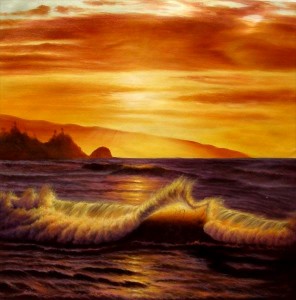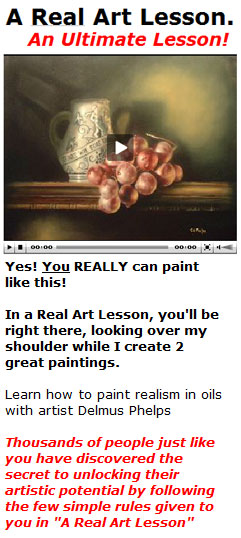Painting Color and Light
Posted by admin | Under Color Saturday Apr 24, 2010 The symphony of color is best revealed to the artist during the hours of sunrise or sunset. At this time of day the colors in the sky and the ocean are at their height. A meadow overlooking the rocks and ocean and cove is a world of its own, a good vantage point. One may spend hours here observing the beauty of the quick-changing sunset with the following after-glow. The sketches for “Late Afternoon” and “Evening” were made here with the companionship of a mild summer breeze, the graceful movements of the grasses and the outcropping of the rocks leading to the ocean below. This evening the ocean is caught in slow motion, its large gentle swells easing into the rocks, playing into the crevices and creating eddies, the spumes splashing skyward, foam in abundance. The war of ocean and rocks has ceased, the evening sky is now advancing to play her melody of color upon the shimmering surface of the earth.
The symphony of color is best revealed to the artist during the hours of sunrise or sunset. At this time of day the colors in the sky and the ocean are at their height. A meadow overlooking the rocks and ocean and cove is a world of its own, a good vantage point. One may spend hours here observing the beauty of the quick-changing sunset with the following after-glow. The sketches for “Late Afternoon” and “Evening” were made here with the companionship of a mild summer breeze, the graceful movements of the grasses and the outcropping of the rocks leading to the ocean below. This evening the ocean is caught in slow motion, its large gentle swells easing into the rocks, playing into the crevices and creating eddies, the spumes splashing skyward, foam in abundance. The war of ocean and rocks has ceased, the evening sky is now advancing to play her melody of color upon the shimmering surface of the earth.
Perpendicular lines for motion were used in the painting of the “Following ocean” to denote action and violence. Here the opposite is true. The horizontal plays a major part in maintaining quiet and a sense of peacefulness. The horizon is quiet also, as though one could easily slip over the curve of the earth. The sky too holds basically to the horizontal. Only the rocks have some perpendicular movement showing their disdain for the changing moody ocean.
The palette selected for “Evening” was cadmium yellow light, cadmium orange, cadmium red light, alizarin crimson, ultramarine blue and Prussian I blue-ultramarine blue for the violet side of the spectrum, and Prussian blue for the green side.
One may observe very easily the use of complementary colors in painting this type of picture: Yellow for the glints of light on the clouds in the sky against the violets in the foam of the foreground and the shadows of the rocks; orange for the light on the clouds as they recede from the source of light against the blue zenith being reflected on the ocean below; pink for the lights on the clouds that are still more distant from the source of light against I the greens of the sky and the reflection in the ocean and foam of the foreground.
In the late afternoon and evening, colors and values change very rapidly I and it is rather hard to make sketches that are complete. One must work very fast and small so as to capture the essence of the moment. I have found the use of very heavy (300-lb.) water-color paper tacked to a small board useful to work on with oil paint, turpentine being the vehicle. The watercolor paper, being absorbent, dries the paints sufficiently fast to allow me to work one color over the other and to arrive at a very quick effect. Casein paints can be used similarly. But with oils the dark tones stay dark and do not dry out of value as much as a water-based paint does.
When the brilliant colors have faded from the sky, and greys, blues and violets have taken their place, my sketches are finished. It is time to return to the studio. I am not the only one calling it a day. The clatter of the gulls has ceased. The flowers in the meadow that faithfully follow the course of the sun on its trip across the zenith have closed their petals. Quiet prevails. Only the sound of the never-ending ocean disturbs the air.
On subsequent days while working on a canvas made up of a composite of my sketches, it will be very important that I retain the feelings and mood of that evening in the meadow. You cannot think a storm and paint a quiet picture. Art rises above mechanical procedures. The artist with a sound background who is creative can and should live the mood of the picture he is painting.
